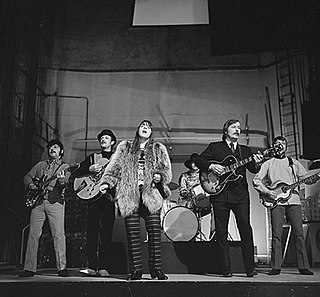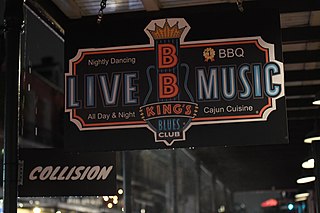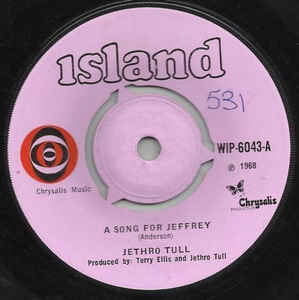
Psychedelic rock is a rock music genre that is inspired, influenced, or representative of psychedelic culture, which is centered on perception-altering hallucinogenic drugs. The music incorporated new electronic sound effects and recording techniques, extended instrumental solos, and improvisation. Many psychedelic groups differ in style, and the label is often applied spuriously.
Hard rock or heavy rock is a heavier subgenre of rock music typified by aggressive vocals and distorted electric guitars. Hard rock began in the mid-1960s with the garage, psychedelic and blues rock movements. Some of the earliest hard rock music was produced by the Kinks, the Who, the Rolling Stones, Cream, Vanilla Fudge, and the Jimi Hendrix Experience. In the late 1960s, bands such as Blue Cheer, the Jeff Beck Group, Iron Butterfly, Led Zeppelin, Golden Earring, Steppenwolf, and Deep Purple also produced hard rock.
Electric blues is blues music distinguished by the use of electric amplification for musical instruments. The guitar was the first instrument to be popularly amplified and used by early pioneers T-Bone Walker in the late 1930s and John Lee Hooker and Muddy Waters in the 1940s. Their styles developed into West Coast blues, Detroit blues, and post-World War II Chicago blues, which differed from earlier, predominantly acoustic-style blues. By the early 1950s, Little Walter was a featured soloist on blues harmonica using a small hand-held microphone fed into a guitar amplifier. Although it took a little longer, the electric bass guitar gradually replaced the stand-up bass by the early 1960s. Electric organs and especially keyboards later became widely used in electric blues.
British blues is a form of music derived from American blues that originated in the late 1950s, and reached its height of mainstream popularity in the 1960s. In Britain, blues developed a distinctive and influential style dominated by electric guitar, and made international stars of several proponents of the genre, including the Rolling Stones, the Animals, the Yardbirds, Eric Clapton, Fleetwood Mac and Led Zeppelin.

Small Faces is the second studio album by Small Faces, released through Immediate Records on 23 June 1967. Although this was their first album for new manager Andrew Loog Oldham's Immediate label, recording actually commenced during their tenure with Decca Records, whom they left in January 1967 after severing professional ties with original manager Don Arden. As a result of the switch of label and management, Decca and Arden released an outtakes compilation album, From the Beginning in early June 1967 in order to sabotage the chart success of the Immediate Small Faces release - something that it managed to do to some extent when From the Beginning reached number 17 in the UK charts. The Immediate album shares its name with their 1966 Decca debut album, which has led to some confusion regarding the titles. As a result of this, it has been unofficially dubbed The First Immediate Album by several fans.
Roots rock is a genre of rock music that looks back to rock's origins in folk, blues and country music. It is seen as responses to the perceived excesses of the dominant psychedelic and the developing progressive rock. Because roots music (Americana) is often used to mean folk and world musical forms, roots rock is sometimes used in a broad sense to describe any rock music that incorporates elements of this music. In the 1980s, roots rock enjoyed a revival in response to trends in punk rock, new wave, and heavy metal music.

American rock has its roots from 1940s and 1950s rock and roll, rhythm and blues, and country music, and also draws from folk music, jazz, blues, and classical music. American rock music was further influenced by the British Invasion of the American pop charts from 1964 and resulted in the development of psychedelic rock.
The Psychedelic era was the time of social, musical and artistic change influenced by psychedelic drugs, occurring from the mid-1960s to mid-1970s. The era was defined by the proliferation of LSD and its following influence in the development of psychedelic music and psychedelic film in the Western world.
Psychedelic soul is a music genre that emerged in the late 1960s and saw Black soul musicians embrace elements of psychedelic rock, including its production techniques, instrumentation, effects units and drug influences. It came to prominence in the late 1960s and continued into the 1970s, playing a major role in the development of funk and disco.

Spanky and Our Gang was an American 1960s sunshine pop band led by Elaine "Spanky" McFarlane. The band derives its name from Hal Roach's Our Gang comedies of the 1930s, because of the similarity of McFarlane's surname with that of George McFarland (Spanky). The group was known for its vocal harmonies and had major hits in the US and Canada in 1967–1968 with "Sunday Will Never Be the Same," "Lazy Day," "Sunday Mornin'," and "Like to Get to Know You."
Psychedelic pop is pop music that contains musical characteristics associated with psychedelic music. Developing in the mid-to-late 1960s, elements included "trippy" features such as fuzz guitars, tape manipulation, backwards recording, sitars, and Beach Boys-style harmonies, wedded to melodic songs with tight song structures. The style lasted into the early 1970s. It has seen revivals in subsequent decades by neo-psychedelic artists.

New Orleans blues is a subgenre of blues that developed in and around the city of New Orleans, influenced by jazz and Caribbean music. It is dominated by piano and saxophone, but also produced guitar bluesmen.
"Don’t Make Promises" was the first track on Tim Hardin's debut album Tim Hardin 1, released in 1966. The song, along with "Reason to Believe," was one of the two major songwriting hits from the album, with more than a dozen cover versions having been recorded following its release. British radio presenter and writer Charlie Gillett noted the song's ability to achieve "the elusive balance between personal miseries and universal sufferings," while author Mark Brend praised the song's "fragile pop sensibilities" and how it contrasted with the "swaggering" R&B of album track "Ain't Gonna Do Without."
This article includes an overview of the events and trends in popular music in the 1960s.
Post-Britpop is an alternative rock subgenre and is the period in the late 1990s and early 2000s, following Britpop, when the media were identifying a "new generation" or "second wave" of guitar bands influenced by acts like Oasis and Blur, but with less overt British concerns in their lyrics and making more use of American rock and indie influences, as well as experimental music. Bands in the post-Britpop era that had been established acts, but gained greater prominence after the decline of Britpop, such as Radiohead and the Verve, and new acts such as Travis, Keane, Snow Patrol, Stereophonics, Feeder, and particularly Coldplay, achieved much wider international success than most of the Britpop groups that had preceded them, and were some of the most commercially successful acts of the late 1990s and early 2000s.
Music of the United Kingdom developed in the 1960s into one of the leading forms of popular music in the modern world. By the early 1960s the British had developed a viable national music industry and began to produce adapted forms of American music in Beat music and British blues which would be re-exported to America by bands such as The Beatles, The Animals and the Rolling Stones. This helped to make the dominant forms of popular music something of a shared Anglo-American creation, and led to the growing distinction between pop and rock music, which began to develop into diverse and creative subgenres that would characterise the form throughout the rest of the twentieth century.
"Other Arms" is a rock song performed by English rock singer Robert Plant, the first track from his 1983 album The Principle of Moments. It was Plant's first number-one hit on the Billboard Top Tracks chart.

Popular music of the United States in the 1960s became innately tied up into causes, opposing certain ideas, influenced by the sexual revolution, feminism, Black Power and environmentalism. This trend took place in a tumultuous period of massive public, unrest in the United States which consisted of the Cold War, Vietnam War, and Civil Rights Movement.

"A Song for Jeffrey" is a song recorded by the English progressive rock band Jethro Tull, released as their second single in the U.K. However, in the U.S., it was the B-side to "Love Story". It is written in honour of Ian Anderson's friend and future Jethro Tull bassist Jeffrey Hammond. Another version of the song was recorded for play on BBC radio.







